All hope may seem lost as we await Phase II of our interrogation at the hands of Kylo Ren… But just then, a super-heated point of light appears on the cell wall and traces the shape of a door. Our rescue has arrived. A piece of the cell is pulled away – its molten edges cut with a laser – as members of the Resistance burst in with a risky rescue plan to get us back to Batuu…
4. The Prisoner Transport Unit & R-5
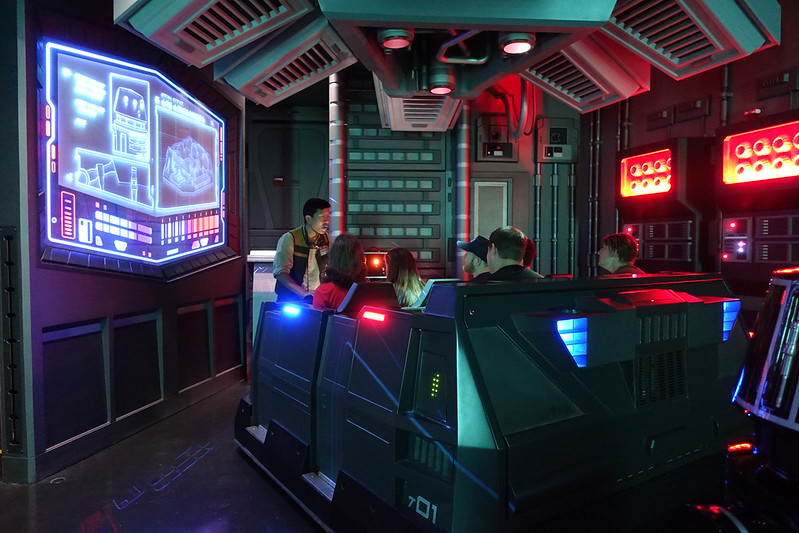
Behind the newly-opened wall, we find two Prisoner Transport Units piloted by R-5 droids, sitting askew in a small chamber. We climb aboard as the Resistance leaders explain that our R-5s have been reprogrammed to navigate through the Star Destroyer and get us to its Escape Pods, where they’ll pilot us back to the encampment on Batuu. With Lieutenant Bek on comms to help us make sense of the ship’s maze-like interior, a sliding wall opens as R-5 pilots us out into the interior of the Finalizer.
The first encounter is an unexpected meeting with other Transport Units (these ones with no human passengers) patrolling the ship, their red-eyed R-5s beeping out an inquiry to our orange-eyed ones. “Tell them it’s a prisoner transfer,” Bek tells our on-board pilot. With a return squeal, our R-5s get us past our first hurdle. A dead-end leads to a narrow escape from a floating Probe Droid, then the path to the Turbo Lifts is clear… except for some patrolling Stormtroopers, who sound the alarm and send us scurrying deeper into the ship…
How It Works
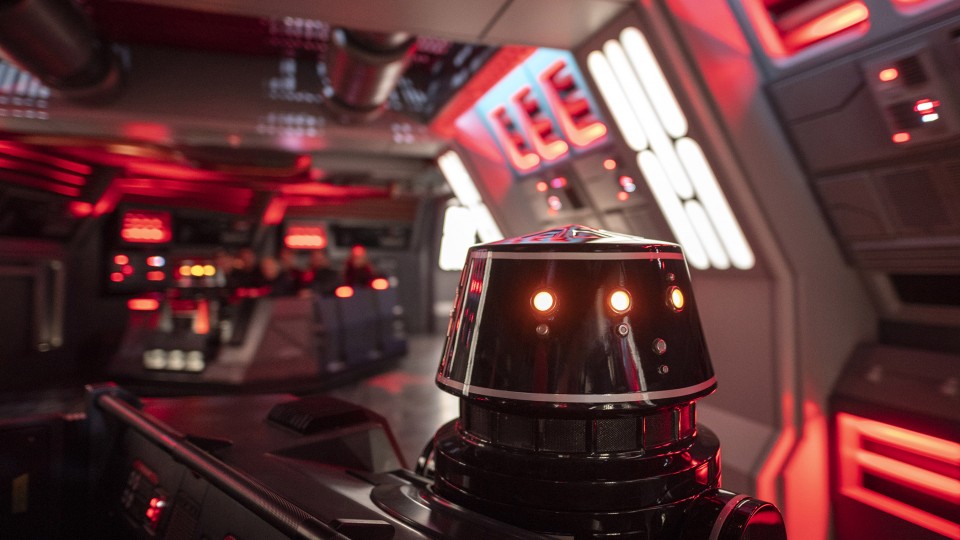
The Prisoner Transport Units are, of course, trackless dark ride vehicles, using Disney’s “LPS” (that’s local positioning system) technology. Each vehicle follows a programmed route through the attraction, using RFID pucks embedded in the floor to communicate its position. “LPS” dark rides aren’t uncommon at Disney Parks (think Ratatouille, Mystic Manor, Runaway Railway, and more) but their introduction in Rise is. Entering a room with two of them simply parked is pretty amazing. Guests don’t step off of a loading platform or wait for air gates to open; they literally just walk into a room with two vehicles askew and climb into them, unsure where they’ll head first. (Depending on your cell, sometimes the vehicles first move forward; sometimes, backward.)
What’s also cool is the R-5 unit that goes along for the ride. The on-board Animatronic has been “reprogrammed” by the Resistance to deliver us to the Star Destroyer’s Escape Pods (indicated by its orange-eyes). The empty, patrolling Prisoner Transport Units we pass with their glowing red eyes are only playing the part of “bad guy” momentarily. They’re actually vehicles that just finished the attraction, and are returning to their own cell-adjacent rooms where their eyes will turn orange just in time for another group of recruits to board. Still, it’s delightful that Imagineers turned the otherwise-not-show-appropriate recycling of empty vehicles into a clever moment!
Imagineering Ingredients
Given that Rise of the Resistance is considered a pretty exhilarating and even slightly scary ride, it may be surprising to say that this trick is made possible by perhaps the least intimidating dark ride Disney Imagineers have ever designed…
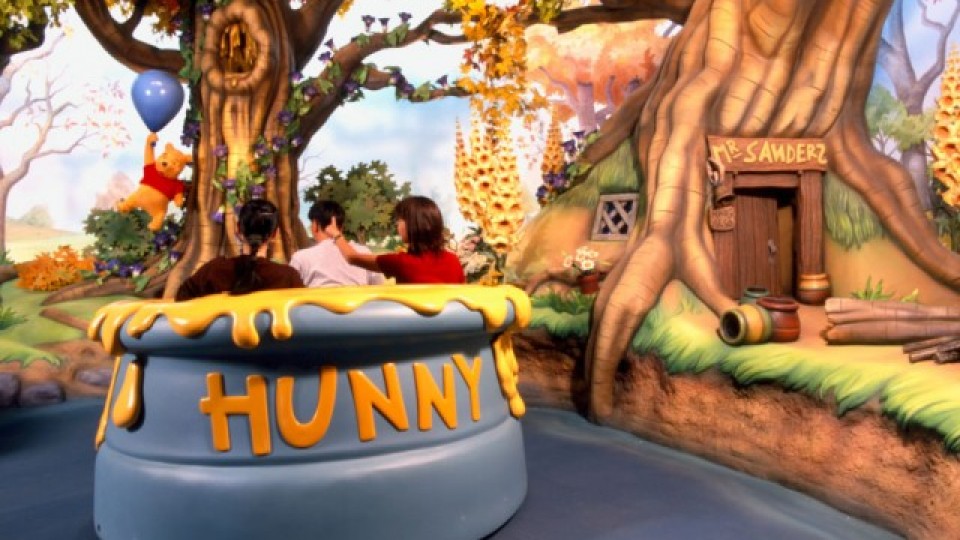
- Pooh’s Hunny Hunt at Tokyo Disneyland was the first of Disney’s dark rides to premier new trackless technology. Using “LPS” (local positioning systems – typically, RFID pucks embedded in the ground), the ride allows a series of “hunny pots” to exit the load area and do the unthinkable. Aboard Pooh, the vehicles appear to “choose” different routes through scenes, spin and reverse, and even dance around each other in careful coordination. Interestingly, during the Tokyo ride’s “Heffalumps and Woozles” scene, a new hunny pot – this one ridden by Heffalumps and Woozles – enters the “dance,” setting an awesome precedent for the units being part of the story in Rise.
- STAR TOURS also gets a nod for a small reason… like the original Star Wars ride, the idea of having an Audio-Animatronic along for the ride is simple, but highly compelling. In this case, the R-5 units that pilot the First Order’s Prisoner Transports become a character in their own right if you bother to watch them. They chirp, holler, turn to face the action, and rotate their heads 180 degrees before reversing. It’s a simple but effective way to explain why and how our vehicles are driving around on their own and making “choices” about which path to follow, while also putting us closer to an animatronic than most of us have probably ever been.
5. The Hangar and Bridge
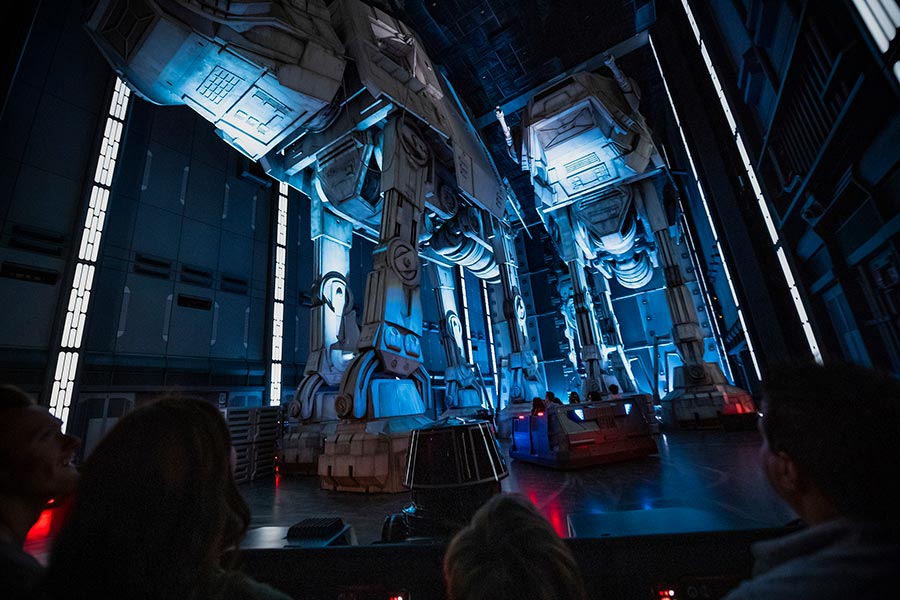
With news of our prison break spreading through the ship and Stormtroopers on the lookout, R-5 is forced to find an alternate route to the Escape Pods. Wouldn’t you know it? That path takes us into a Hangar housing full-sized AT-ATs. The breathtaking turn into the massive chamber is one of Rise’s most jaw-dropping moments, and one of the biggest scenic reveals in Disney Parks. Our path is cut off as Stormtroopers descend, firing laser blasts through the air.
With no clear way out, the vehicles back into gantry lifts to carry them down to the Pods… but of course, they accidentally rise instead.

Momentarily escaping the mayhem and laser fire, the vehicles arrive at the Bridge, where Hux and Ren learn of the prisoners’ escape just as Poe and the Resistance return. Ren senses our presence. “How brave,” he says as he turns toward us, “yet ultimately hopeless.” As R-5 speeds away backwards, Ren chides, “There’s nowhere to run.”
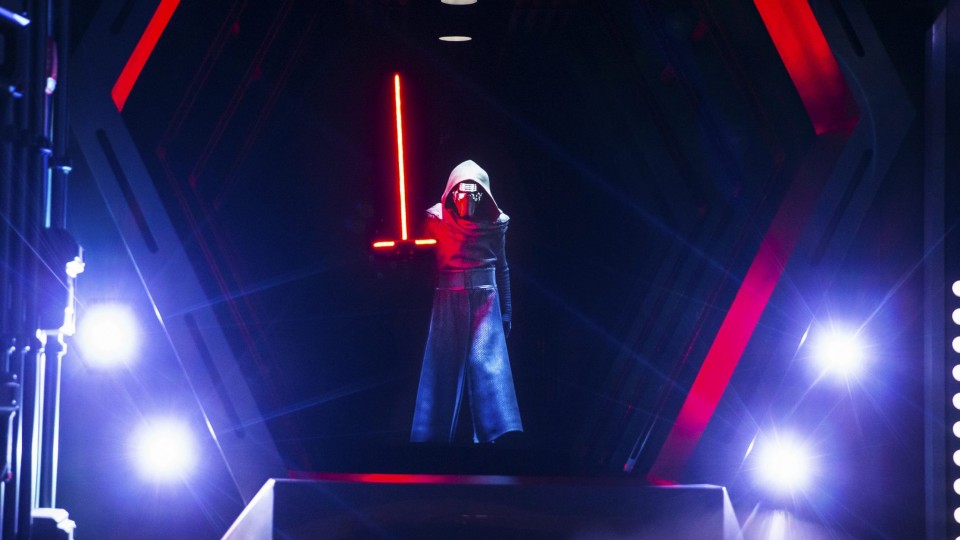
At last, the vehicles back into a Turbo Lift as searing white security lights shine directly onto us… Ahead, Kylo Ren jumps down from above, ignites his jerry-rigged Lightsaber, and physically advances toward us. The lift doors close just in time and our descent to the Escape Pods is at last assured… Right?
How It Works
During the attack in the Hangar, the two PTUs split up, taking one of two gantry lifts up to the highest floor of the Hangar. Once parked on the lift, low-level gates rise to ensure the lift can’t advance forward. The first is fired on by First Order troopers with a laser cannon; the second is right in the pathway of an AT-ATs blasters. In both cases, lighting and projection make the laser blasts appear to travel through the air and cause physical damage.
Riders’ escape from the Bridge is an impressive effect. After encountering Hux and Kylo Ren as Audio-Animatronics, the vehicles reverse toward the open Lifts while Kylo gives chase.

The Ren that drops from the ceiling, stands, and begins walking toward the Lift is a projection, but you’d be forgiven for being fooled. He’s projected onto a screen that does physically move toward riders. To make the encounter even more real, the Lightsaber is a practical effect. It actually does ignite and swing in perfect coordination with the advancing projection. (Park Lore Members can view a gallery of the patent images filed by Disney to get a better idea of how this very unique effect works.)
Imagineering Ingredients
Aside from the clever walking Kylo Ren effect (which we honestly can’t think of a precedent for), the past projects that echo this portion of the ride aren’t about specific effects or moments, but the ride’s scale and technology.
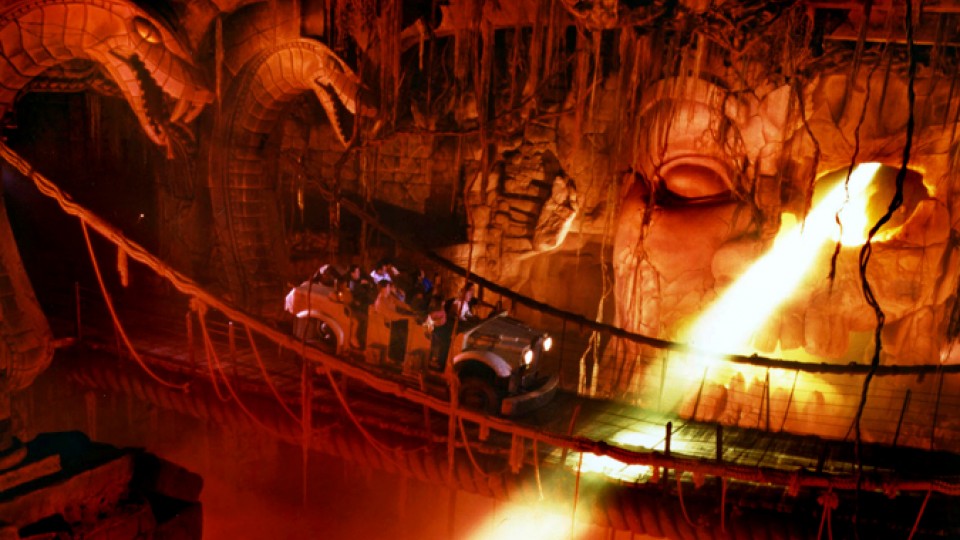
- Indiana Jones Adventure must be the Imagineering “ingredient” that leads to the Hangar. That ride’s central chamber (literally, “The Big Room” in blueprints) is a massive, collapsing temple interior reigned over by the decaying face of Mara, its half-skeletal visage firing off energy blasts. Riders spend a surprising amount of time in the “Big Room,” darting in and out of caverns around its perimeter, crossing a shaky suspension bridge over its central lava pit, and even passing behind the face of Mara. The scale of Indiana Jones Adventure’s “Big Room” was unlike anything seen before – and arguably, wasn’t surpassed until Rise of the Resistance, where the Hangar awaits.
- The Twilight Zone Tower of Terror adds one of its secrets to Rise’s playbook again: the mid-ride elevator to another level. In fact, just like on Rise, each “elevator” on Tower of Terror is technically a very large, 21-seat trackless, LPS vehicle. The only difference is that it starts the ride already locked into a separate “vertical vehicle conveyance” system (VVC) that’s used to lift the ride through its two show floors. In the “5th Dimension” scene, however, the LPS vehicle drives itself off of the VVC, navigates horizontally, and locks itself into a second, high-speed VVC shell for the drop portion of the ride. Rise is doing the same thing, just inverted in order. Rise is LPS-VVC-LPS versus Tower of Terror’s VVC-LPS-VVC. Get it?
6. The Turbo Lift
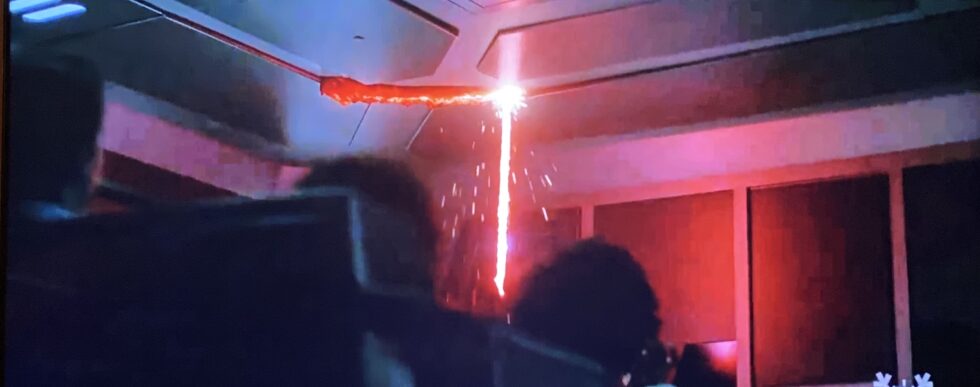
With the doors closed and Kylo Ren successfully left behind, the Turbo Lift begins is rapid descent to the Finalizer’s lower levels, where the Escape Pods await. Floors whiz by in quick succession outside and a moment of peace finally seems at hand. But just then, R-5 squeals and recoils as Kylo Ren’s distinctively erratic, sparking, over-powered Lightsaber blade pierces through the lift’s ceiling and begins to saw at it, effortlessly melting the start of a hole into the roof. Before he can finish it, the lift comes to a stop and R-5 races out.
How It Works
After being fooled by the Transport and actually boarding a Lift that actually did change your elevation, you might hedge your bets by assuming that the Turbo Lift actually is going somewhere. In this case, it isn’t. The two Turbo Lifts that carry you “down” to the Escape Pod level aren’t real lifts. The passing floors are projections… and believe it or not, you already saw the projectors – the blinding white “security lights” that flanked the walking Kylo Ren!
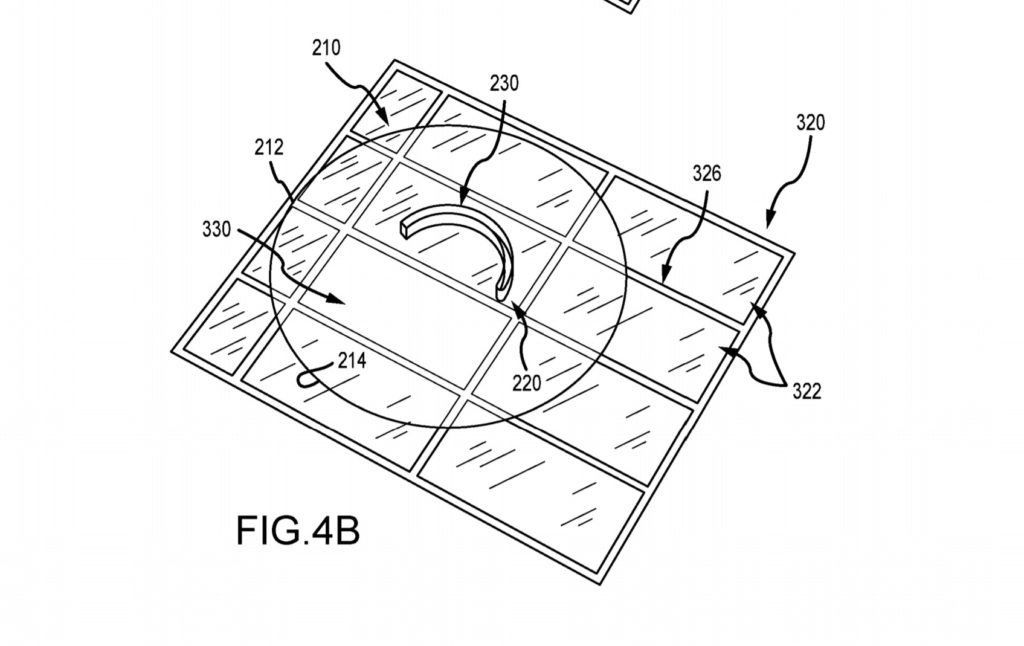
Obviously, though, the piece de resistance of the Turbo Lift is an effect that’s likely to leave most riders totally bamboozled – Ren’s Lightsaber. For how absolutely jaw-dropping it is, the effect is actually surprisingly simple in execution. A circular panel embedded in the ceiling already has a semi-circular cutout. When the scene begins, the panel revolves into position, with the first bit of that cutout revealed. The Lightsaber blade is then pierced down through the opening.
Perhaps the most impressive element of the effect is how Ren’s sizzling, uneven, fractal, blade looks so genuinely erratic. The answer? The blade is rapidly spinning, giving its illuminated, textured surface the sort of sparking, electrical, uncontrolled quality Ren’s manipulated blade is known for.
Imagineering Ingredients
- Here, we can finally give a shout out to The Living Seas, which masterfully used the “false elevator” scene to make guests feel they were descending to an underwater Sea Base in “Hydrolators.” The “false elevator” is a frequent trope in themed entertainment, though, which makes sense – the effect can be simple (a little rumbling room as a rotating scrim outside of a window shows passing rockwork) or technological (like Space 220’s “Stellavator” or Escape From Gringotts’ bank lifts).
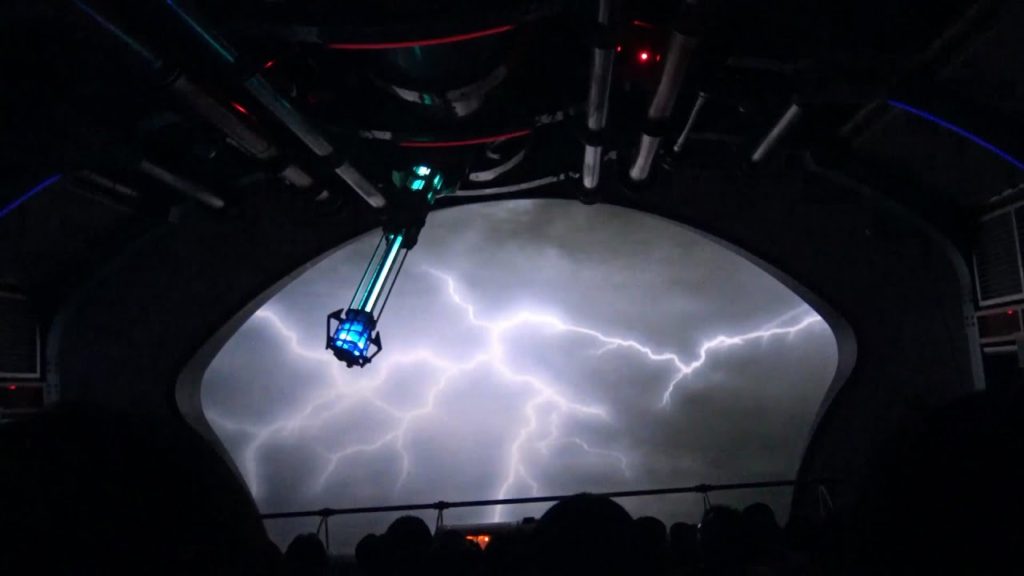
- StormRider, the now-Pixarified motion simulator at Tokyo DisneySea offered an unusual “ingredient” here… On board futuristic storm-chasing vehicles, guests were charged with racing headlong into a hurricane to release a data-gathering, storm-calming probe into its eye. But a mis-fire actually saw the launched probe do a 180, rocking back toward the vehicle and puncturing its hull, injecting into the vehicle mid-ride! It was a shocking and very inventive way of bridging the projected world and the physical one, literally bringing the former into the ride vehicle. Ren’s Lightsaber likely owes some amount of its engineering to the trick.


